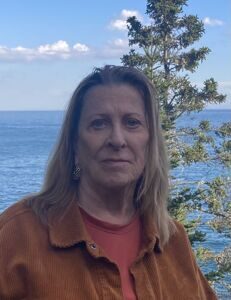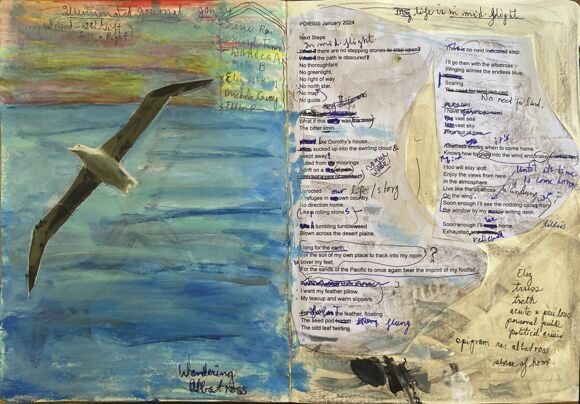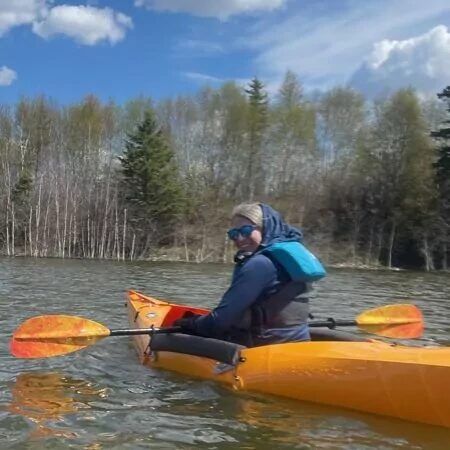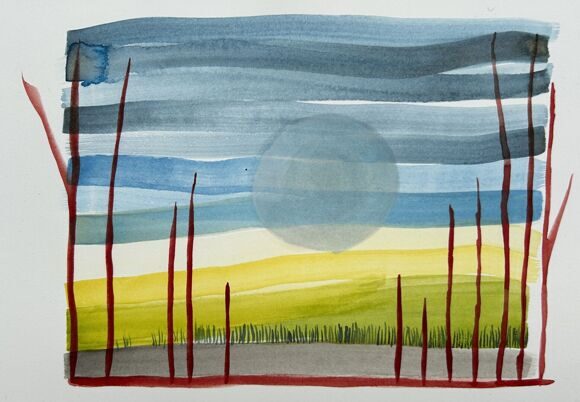IN RESONANCE WITH THE EARTH
We are pleased to introduce new materials for this section of our journal. We see poiesis as providing the basis for human beings' creative responses to the world of nature. The arts in particular offer forms that crystallize these responses in ways that touch and move us. "In Resonance with the Earth" contains poetry, artworks, photography and essays relevant to this theme. In this issue of the journal, this section includes poetry and artworks by Judith Greer Essex and Jenna Montgomery and a new series of poems by Stephen K. Levine and Alexander Kopytin.
THE ALBATROSS AND ME*
*reprinted with permission from “POIESIS: A Journal of the Arts and Communication”, 2024, Vol. 21

Judith Greer Essex
Ph.D. LMFT, ADTR, REAT. She is a professor at the European Graduate School in Saas Fee, Switzerland and founding director of The Expressive Arts Institute in San Diego. Judith teaches community art-making to facilitate large groups of people to cooperate and create together. In addition to community art, her special interests include embodiment, improvisation, women’s issues, and androgogy. She has led development workshops and consulting for Sharp Hospital Coronado, Toyota University, Mercy Hospital palliative care team, GSDBA Chamber of Commerce San Diego, Alliant University, and San Diego Repertory Theater, among others.
When Steve Levine put out the call for submissions to Poeisis: a journal of arts and communication with the theme "Next Steps, New Beginnings," I contemplated my life: What is beginning and what are my next steps? Brain fog and lack of direction for my future seem my daily atmosphere. I have no secure footing, no definite plan. That unsettling reality crawled into my lap. Then came an image of the wandering albatross.
On occasion, an animal comes to me, either as a living creature or as a mental image. It says, “Hello,” and we have an encounter. When this happens, I consider it seriously: the circumstances of our meeting, what I was doing when we met, what it was doing, and what sensations, emotions, thoughts, and memories I might have concerning our meeting. I do not consult a book on animal medicine–someone else’s traditions and ideas. Instead, I consult zoological information about that animal: young or old, male or female, at rest or traveling, endangered or safe. I want to know the individual. The unique visitation by this being and our relationship can reveal its significance to me. I sit with the image and move in a way reminiscent of the animal, as if it had my body or as if my spirit could live in that body. Looking at many photographs of it, imagining myself in its body and locale, I draw it. This kind of research takes many hours. My journal holds my reflections. I glean and gather what messages I might receive from my four-legged, finned, or feathered family that can translate to my current reality.
As I contemplated the life of the albatross, at home in the sky, soaring for years at a time, sleeping on the wing, it brought me some measure of peace. Here was a creature who lived without knowing the next step. Could I take a lesson from the albatross?

In Mid-flight
There are no stepping stones,
The path is obscured.
No thoroughfare
or right of way
No green light
No north star
No guide
No map.
This is the bitter limin
Like Dorothy’s house,
sucked up into the swirling cloud
And swept away;
Pulled from moorings,
adrift on a rogue wave;
Uprooted–
A tumbleweed tumbling,
No direction home.
I long for
My feather pillow
My teacup and warm slippers.
A feather is floating
A seed pod flung
The odd leaf twirling
No
next
indicated
step.
I’ll go then with the wandering albatross,
winging across the endless blue
Soaring
No need for land
Vast sea
Vast sky
Soon enough I’ll see the nodding calla lilies
Out the window by my writing desk
Soon enough
Exhausted
Relieved
Home.
CLEARING SPACE FOR WILDFLOWER SEASON*
*reprinted with permission from “POIESIS: A Journal of the Arts and Communication”, 2024, Vol. 21

Jenna Montgomery
is a Canadian artist and polymath who currently resides in Edmonton, Aberta, Canada, on treaty lands where reconciliation is still a work in progress. She has a CAGS in expressive arts leadership from the European Graduate School and is interested in the interplay between art, nature and community.
One morning while getting to know some new watercolour pigments, I had a decentering experience. It began as just a curious exploration of what the new pigments looked like on the paper. There was very little skill involved. I applied the paint in loose horizontal lines. Once I knew what these pigments were, I started varying my marks and the experience became more playful. Soon enough the little painting we see here emerged with something to say. Willing to stay with it, I moved into playing with words. The poem was the result. Now as I sit with this poem and painting, where I’m coming from and what is meaningful to me is reflected back. The community spaces that I knew prior to the pandemic are starting to reform and take life again. However, it has been slow, and there are valued communities that are still missing. I support the building of community but have never seen myself as a community builder. This little decentering exercise has shown me a door, and through that door, I can see that I do have the skills to build community, and I can start by clearing space. Once again, the principles of expressive arts have helped me to uncover the door to my own wisdom.

The threshold is there, right there
Open to all who lend their attention.
The gates have withered.
Attention is a commodity.
Behind the gates - dry, hard, barren
Desperately waiting
Begging I can almost touch it.
Can you?
To cross through is something more
Timeless, even
With leaf-bearing branches stripped from the gates,
You and I
sweep the sky
making space for the light to come through
Fields and pastures come to life
A newly sprouted carpet to run and dance upon
making place with the emergent
Tossing our shoes aside, baring our toes and ankles
Tender blades of grass, first tickle then poke
sharp until they bend under our weight
Chasing our steps, they spring back
elated and excited for what is to come.
Wildflower season will soon be here.

